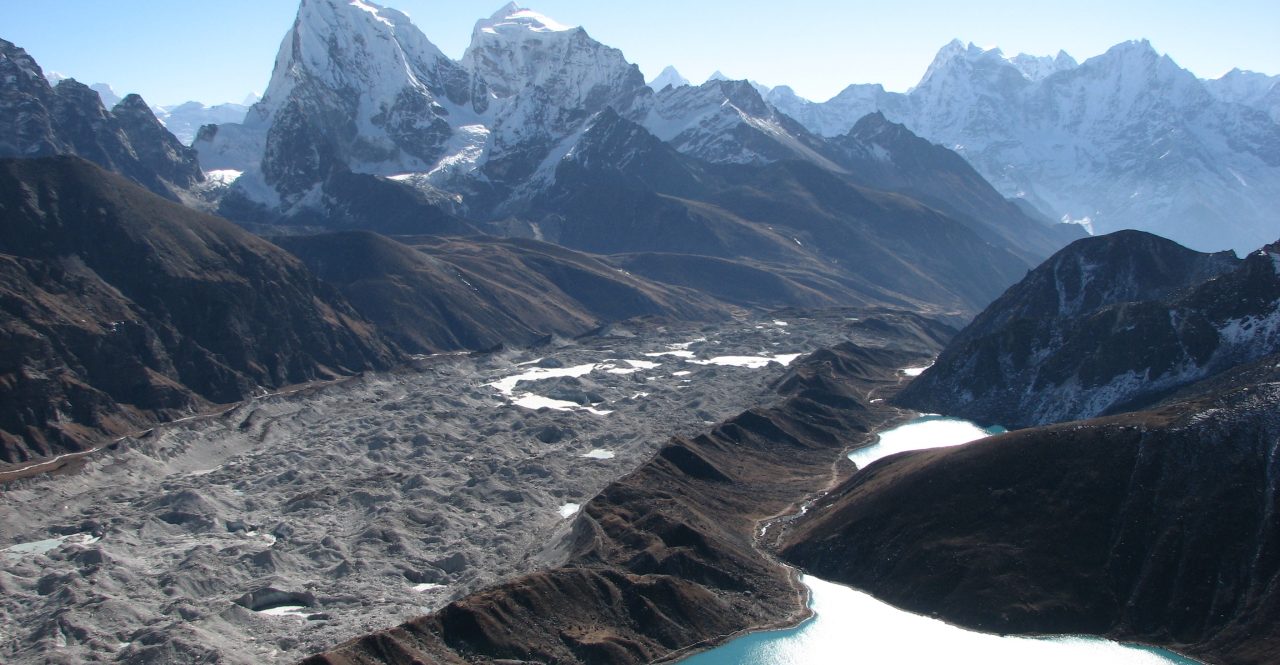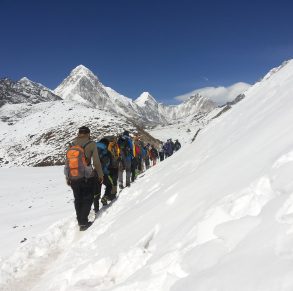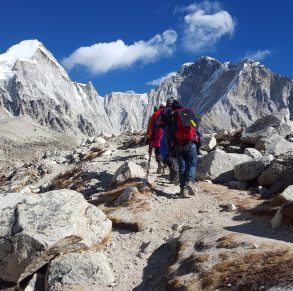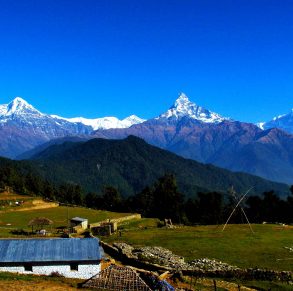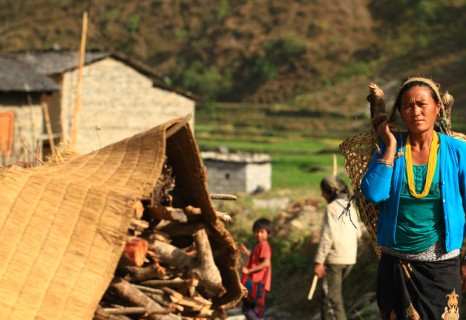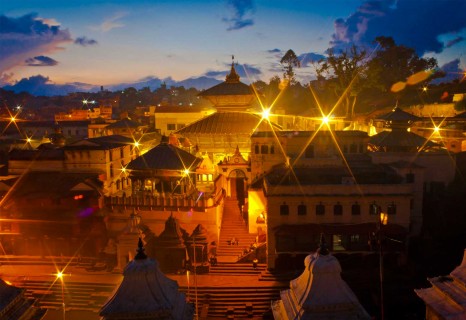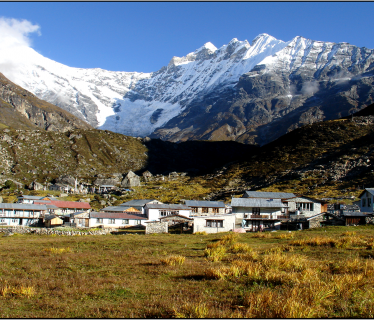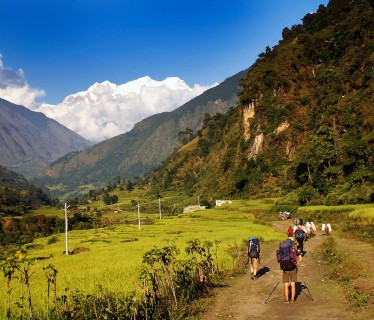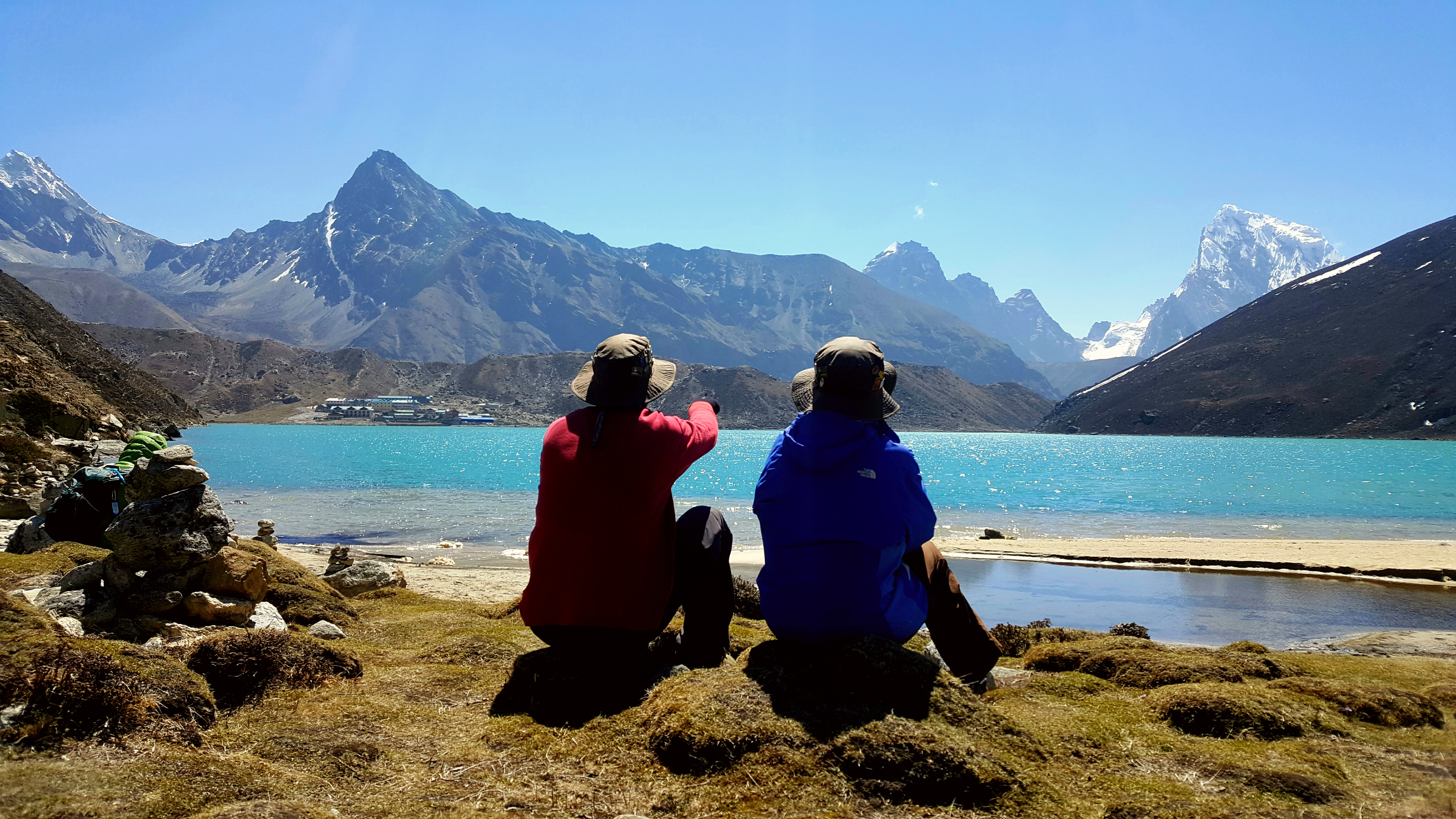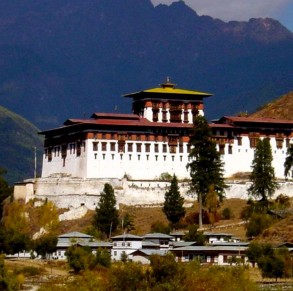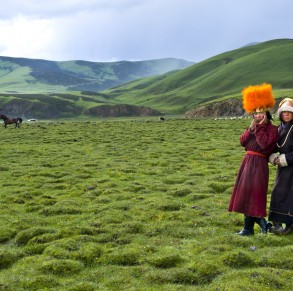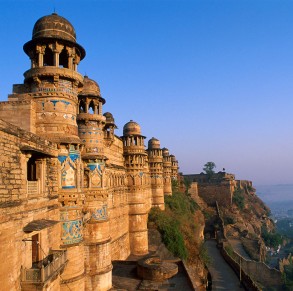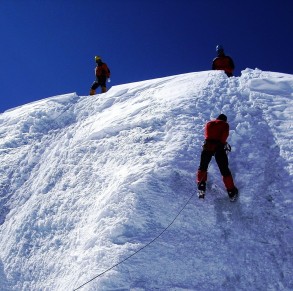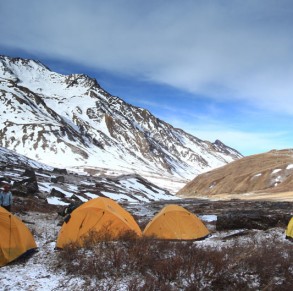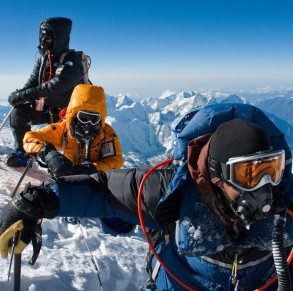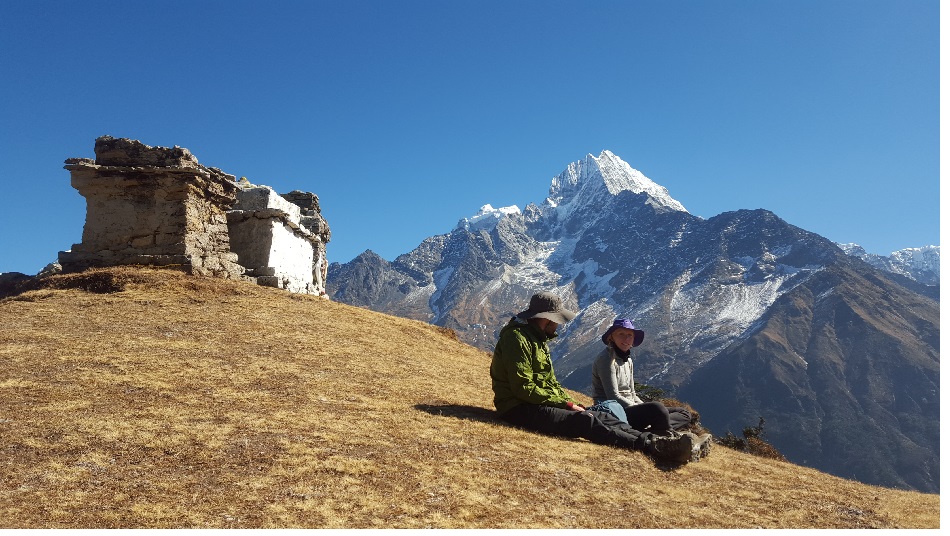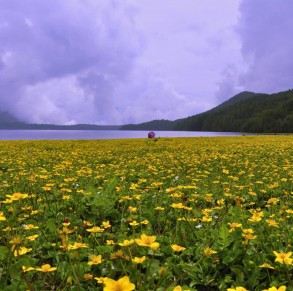Day 01: Kathmandu/Lukla by flight. Trek to Phakding (2610 m.)
Day 02: Trek to Namche Bazaar (3,440 m) 5 – 6 hrs walk.
Day 03: Acclimatization in Namche Bazaar
Day 04: Trek to Tengboche (3837 m.) 4 – 5 hrs walk.
Day 05: Trek to Pheriche (4252 m) 5 – 6 hrs walk.
Day 06: Rest day in Pheriche
Day 07: Trek to Lobuche (4930m) 5 – 6 hrs walk.
Day 08: Lobuche to Everest base camp (5364 m.) and to Gorakshep (5160 m)
Day 09: Visit Kalapatthar and trek to Dzongla (4843 m.)
Day 1o: Dzongla – cross Chola Pass to Thangnak (4700 m.)
Day 11: Thangnak to Gokyo (4791 m.)
Day 12: Hike up to Gokyo Ri and back to Machhermo (4465 m.)
Day 13: Machhermo to Namche Bazaar (3440 m.)
Day 14: Namche to Lukla (2860 m.)
Day 15: Lukla to Kathmandu by flight (35 min flight)
Day 16&17: Free day in Kathmandu.
Day 01: Kathmandu/Lukla by flight. Trek to Phakding (2610 m.)
After a 35 minutes mountain view flight you will land in Lukla, a Sherpa village located in the Khumbu region of Solukhumbu district. Immediately after landing in Lukla you will start trek to Phakding.
Day 02: Phakding to Namche (3440 m.)
After breakfast in Phakding, we commence our trek to Namche Bazaar.The trail follows the right bank of the Dudh Koshi river. Today we will enter the Sagarmatha National Park, a conservation area that encompasses the entire Khumbu region. You will also get views of Mt. Thamserku, Everest (8848m) and Lhotse (8516m.). After a steep two hour climb, you will reach Namche Bazaar, which is surrounded on three sides by mountain ranges. Namche is a central hub of the Everest area and also a major trading village for food, trekking gears and other necessary goods. From historical time till today, Tibetans make the arduous journey crossing the Nangpala pass to trade in Namche.
Day 03: Acclimatization day in Namche
Acclimatization is important before proceeding higher. This is the first of two specific acclimatization days that everyone should build into their trek schedule. You can spend the day by taking a day hike to Thami village, by visiting Khunde or Khumjung, or by relaxing and exploring Namche Bazaar.
Day 04: Namche to Tengboche (3837 m.)
There is a direct route from Namche Bazzar to Tengboche that starts at Chhorkung, winds around the hill to the tea and souvenir shops of Kenjoma, and joins the trail in Khumjung just before Sanasa. Tengboche monastery is the heart of religious activity of the Sherpa people of the Khumbu region.
Day 05: Trek to Pheriche (4252 m) 5 – 6 hrs walk.
We descend steeply through a forest, cross the Imja Khola and climb steadily to the village of Pangboche. This is directly opposite Ama Dablam [6856m], and has exceptional views of the mountain, with the gompa, mani walls and scattered pine trees in the foreground. A further two hours walk brings us to Pheriche.
Day 06: Rest day in Pheriche
A day to rest and acclimatize and a chance to wander up the valley to look at a lake, the Tshola Tsho and the perpendicular walls of Cholatse and Tawache. Alternatively, we can climb up onto the ridge overlooking Dingboche for the view up the Imja Valley and the incredible south face of Lhotse.
Day 07: Trek to Lobuche (4930m) 5 – 6 hrs walk.
We continue up the wide valley beneath the impressive peaks of Cholatse and Tawache on the left. We then turn right and climb more steeply towards the foot of the Khumbu Glacier. The tea house at Duglha is a good spot to have lunch, before zigzagging up through the boulders of the glacier’s terminal moraine. At the top of this climb there are many stone cairns, built as memorials to the many Sherpas who have died while climbing Mt Everest. The path then climbs gently along the glacier, to eventually reach the cluster of houses at Lobuche.
Day 08: Lobuche to Everest base camp (5364 m.) and to Gorakshep (5160 m.)
The trail is pretty easy to start with other than the fact we will be height almost at 5000 m. We then started to gradually ascend following the Khumbu glacier up the valley to Lobuche pass. Then there was a steep section then a series of rocky and icy ups and downs. As the sun began to rise, its rays quickly warmed us up, allowing us to move a bit more freely when taking on the next rocky scramble. A short descent brought us to Gorakshep (5160 m.) which is the last village before base camp and our highest sleeping altitude of the trek. Early morning we walk to Everest Base Camp, visit base camp area and walk down to Lobuche. From the Everest Base Camp you can see the north face of Mt. Everest, the famous Khumbu Ice Fall, Lhotse and Nuptse.
Day 09: Visit Kalapatthar and trek to Dzongla (4843 m.)
Early in the morning trek to Kala Patar (5545m) to experience sensational sunrise views from this amazing vantage point. From the lodge the ascent is quite steep, so start very slowly and try to ascend at a steady rhythmic pace. Kala Pathar is the rocky hilltop below Pumori. It is a tough walk because of the altitude, but the view from the top surpasses the wildest imagination. Returning back to lodge and having breakfast we set off our trek. From Lubuche we follow the Lobuche Khola downstream where, after a while, we take a trail to the right heading off towards Dzongla.
Day 10: Dzongla – cross Chola Pass to Thangnak (4700 m.)
The day begins very early in order to reach the top of the pass in the best possible conditions. From Dzongla we ascend steeply on a narrow trail passing large boulders and huge rock slabs and keeping to the left of the main glacier. There are a number of cairns lining the route to the snowfield and, while the trail is well-defined, it does involve a little scrambling. Once on the snowfield the angle eases off and we soon reach the top of the pass (5420m), where the views are spectacular and include Baruntse (7220m) and Ama Dablam, as well as view of lesser peaks. Do not wander around the snowfield as there are crevasses and we may need to rope up for the pass crossing! The descent from the pass is steep and care should be taken as we follow the narrow rocky trail down to the Nymagawa Valley, After lunch we cross rocky screed and boulders and ascend the short distance to a small saddle that leads downhill all the way on an easy trail to the huts and tea houses at Thangnak.
Day 11: Thangnak to Gokyo (4791 m.)
We head off towards the Ngozumba Glacier where we do a touch of boulder hopping as we pass small glacial lakes. The views are astounding as we enjoy different views of the Gokyo Valley as Cho Oyu and adjacent mountains bordering Tibet loom to the right. The trail then reaches the second lake of Gokyo, where we can see Brahmin ducks swimming in pairs and feeding on algae. From the second lake it takes another 45 minutes to reach the settlement of Gokyo where we spend the night.
Day 12: Hike up to Gokyo Ri and back to Machhermo (4465 m.)
Explore Gokyo Lake and then climb Gokyo Ri peak, which takes around 3-4 hrs. The summit of Gokyo Ri offers spectacular views of Makalu, Cho Oyu, Mt. Everest, Bhorunche, and many other surrounding peaks. You can also witness the famous Lungsamba Glaciers that contribute water to the Dhud Kosi river. After explore Gokyo valley and Gokyo lakes, most of the trail goes down gently to Machhermo. On the way we have still chance to see numbers of mountains around.
Day 13: Machhermo to Namche Bazaar (3440 m.)
From Machermo the trial starts descending steeply to Photse Tenga (3650m.) passing through rhododendron forests. Then the path immediately ascends steeply to Mongla Danda (4000m.) and gently descends up to Kyanjoma (3500m.) following small ups and down to the Namche.
Day 14: Namche to Lukla (2860 m.)
This is the last day of the trek and there is plenty of downhill walk from Namche Bazaar to Lukla.
Day 15: Lukla/ Kathmandu by flight. Overnight at hotel in Kathmandu.
We board our early flight from Lukla to Kathmandu. Upon arrival at Kathmandu you will be received by a Snow Leopard Trek representative and transferred to your hotel. Rest day free in Kathmandu for shopping and relax.
Day 16&17: Free day in Kathmandu.
We always recommend our guests who are trekking in the Everest region to have atleast 1 or 2 spare days in Kathmandu before international flight. This is because Lukla weather is unpredictable due to which flight gets delayed or cancelled. If Lukla flight is cancelled then we will try to fly to/from Lukla next day. So for this reason we want our guests to have some spare days in Kathmandu. FYI: You can take helicopter to Lukla also if your Lukla flight is cancelled. But it will be extra costs to take a helicopter flight.



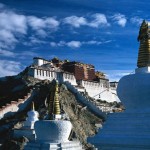
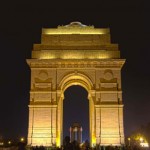

 Español
Español